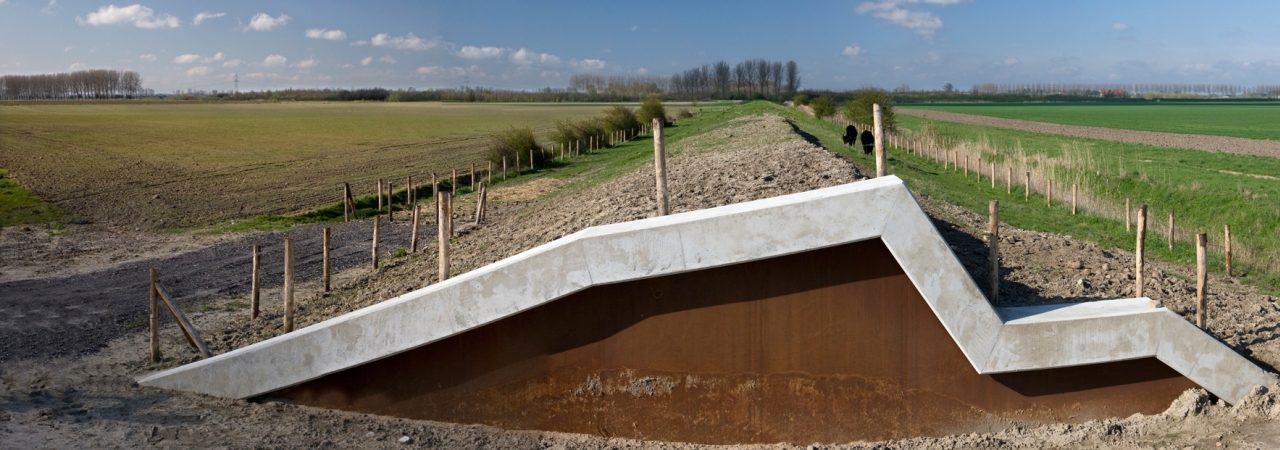The medieval village IJzendijke disappeared in around 1400 following storm floods. Approximately 2 km to the southwest, a hamlet later emerged in a higher place in the flooded area. In 1587, on the orders of the Spanish commander Alexander Farnese, the Duke of Parma, a redoubt was constructed. Slightly to the west, the Spaniards also built the redoubt Boerenverdriet.
In 1604, Prince Maurits landed in Land of Cadzand with a large army. His final goal was Oostende that had been under siege by the Spaniards for nearly three years. In the space of a few days, he conquered western Zeeuws-Vlaanderen. On 4 May, led by Willem Lodewijk and Ernst Casimir van Nassau, troops dug approach trenches to the stronghold IJzendijke. After four days, they reached the outer works. On 5 May, Prince Maurits joined the siege troops. The next day the shooting started and the Spaniards withdrew inside the fortification. Maurits took Boerenverdriet where subsequently a gun emplacement was installed aimed at shooting a hole. The prince sent a trumpeter to the Spaniards to demand the stronghold. However, he was maliciously killed so that at the surrender on 10 May, the Spaniards were only allowed to leave with the least military honour. After the capture of IJzendijke, the redoubt was further expanded and strengthened by the States. The square Spanish redoubt was retained as the heart under the name “Castle” or “Old Fort”. Around about, at some distance, on the north, west and south side, an embankment was constructed containing four bastions. On the south-eastern side, a half bastion was constructed. On the outside of the embankment, there was a moat with counterscarp. On the north-western side, a ravelin was placed in the moat. From the half bastion, a dyke ran to the Jonkvrouwschans.
From the Boerenverdriet redoubt northwards, in a curve a couple of hundred metres from the stronghold, a retranchement was created with a bastion, moat and two ravelins. The redoubt was incorporated in a hornwork.
During the Twelve Years’ Truce, the stronghold was improved according to the principles of the Old Dutch system in the form of a regular hexagon with a bastion on each corner. The “Castle” moat became a harbour. This harbour silted up during the 17th century and was closed up in 1694. After a dyke was built on the Groote Jonkvrouwpolder in 1702, the eastern side of IJzendijke was no longer on open water. For this reason, the ditch and counterscarp were continued to this point.
Op 27 April 1747 (during the War of the Austrian Succession), French troops crossed the Passageule near the Schaapstelle redoubt to the southwest of IJzendijke. IJzendijke was besieged immediately afterwards, surrendering after three days without a shot being fired from the French side. The rest of West-Zeeuws-Vlaanderen was subsequently occupied and remained in French hands for a year and a half, until the signing of the Treaty of Aachen.
In 1816, the stronghold was officially dismantled. During the Belgian Revolution of 1830, the stronghold was partly re-established. In 1841, it was dismantled again. Today the stronghold only consists of the ravelin with surrounding ditch. The ravelin was restored by the municipal council. The street pattern in the centre of IJzendijke is still fairly much the same as it was two centuries ago. The drill yard in the middle of the stronghold is now the market place. From the air, the outline of the stronghold is still recognisable.
A definite eye-catcher is ‘The Bolwerk’, the museum of States-Spanish Lines. Based on a ‘storyteller’, a gps-directed walk in the village, you can experience the Eighty Years’ War for yourself.


